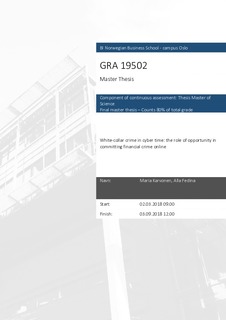| dc.description.abstract | The advent and expansion of Internet-enabled technology made likely the
accomplishment of remarkable improvements in research, expertise, and
communication. Unfortunately, computers and the Internet have furthermore
supplied a new natural environment for crime. As pointed out by Jaishankar (2011),
with the introduction of the Internet and subsequent possibilities, various forms of
crime that have long existed before computer access require altered definitions to
include the new ways these crimes can be committed.
This paper provides with an overview on white-collar crime and suggests
that committing financial crime online or through computer-enabled technologies
becomes more attractive for the offenders from opportunity perspective of the
convenience theory. The purpose of this study was to contribute to the discussion
on white-collar crime by identifying several characteristics of cyberspace that
increase an attractiveness of engaging in online crime and finding the specifics of
committing that crime from different perspectives in cyber context, followed by
providing a foundation for further research in this field.
As a result of the study, there were severalised advantageous characteristics
of the Internet related to crime category, criminals, crime type, situations and
convenience dimensions. The findings of this research suggest ten factors that make
online crime more attractive and convenient option. Seven of these factors were
obtained through analysis of secondary and primary data: disconnected nature of
personal communication, anonymity, geographical and timing distance, network
size effect, low cost standard, no need for violence, and weak law regulation. The
remaining three factors were empirically identified by experts in the field of
cybersecurity and financial crime: larger rewards and returns on investment;
automatization of the crime; and the dematerialisation of the crime. The findings
also suggest that factors differ in terms of their positioning status. However, the
results also indicate disagreement of experts with some of the stated hypothesis.
Future research is necessary and encourages to examine the need to continue
the academic discourse regarding the boundaries of white-collar crime and whitecollar
cybercrime.
Finally, we consider gamification methods in employee training as a
prevention strategy that could help organizations to mitigate the threat of cyberattacks.
Due to high significance of the subject in the organizational context, there
was provided a detailed overview of the topic.
Key words: white-collar crime, cyber, cyber attack, cybercrime, technology,
convenience theory, opportunity, financial crime, gamification, training. | nb_NO |

